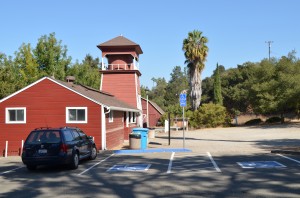
For years, many Cupertino residents and city leaders have wanted a new education center at the McClellan Ranch Preserve, an 18-acre site that is home to a community garden, a portion of the Stevens Creek Trail and more than 100 species of birds. Busloads of schoolchildren arrive there almost daily, barely squeezing into the current center — a converted garage — to participate in the environmental programs.
The city got its wish in 2006, receiving a state grant to help build a new center. But those plans were derailed by a lack of additional funding and eventually the grant expired. Teachers continued to cram their students into a space designed for fewer than 30.
The city persisted. Last year the state agreed to extend the grant deadline, and the City Council recently decided it cannot wait any longer or else risk losing the money again — this time for good. On Oct. 2, the council approved spending $1.1 million to proceed with the building plans.
The project has two parts: a 2,400-square-foot education center and an outdoor gathering shelter of about 400 square feet. Timm Borden, the city’s director of public works, said the building will have two classrooms, a library, a “wet lab” for animal and plant exhibits, teacher stations and offices. He estimates the center will hold about 70 students. The center will be build on the site of the former caretakers’ quarters.
Borden said the state grant would provide $251,000 of the project costs and the city’s $1.1 million would come from a Park Dedication Fund ($800,000) and the Capital Improvement Program Reserve Fund ($349,000).
The grant comes from the Roberti-Z’Berg-Harris program — a part of Proposition 40, which Californians passed in 2002 to fund environmental projects that need urgent attention. This grant is designed for rehabilitating parks and recreation facilities.
“We know there is a capacity to do more,” city Parks and Recreation Director Mark Linder said. “The state obviously agrees because it is very difficult to get Proposition 40 money and we got some. It will be a great learning center.”
Based on ambitious estimates, Borden outlined a plan to begin construction in August 2013 and finish by November 2014. The conditions of the grant extension require the project to be completed by Dec. 31, 2014.
Although the City Council voted unanimously, council member Gilbert Wong did question the aggressive schedule. He felt there would not be sufficient time for the council to provide input on the design plans.

Borden countered by saying there will be little room to tweak designs. The city has committed to general facility plans based on the grant submission. Borden assured the council members that there would be time for their feedback.
Council member Rod G. Sinks said the center will boost the community’s appreciation of biological science and the outdoors. “This opportunity, right in our own backyards, to enhance and bring people out will serve the community very well,” he said.
The city’s senior naturalist, Barbara Banfield, has spent more than 30 years working at the nature preserve. Every third-grader in the Cupertino school district comes out to the reserve for a creek tour as part of their science curriculum. Banfield also organizes K-6 nature walks and high school field trips. She runs most of the environmental programs out of the current center, often juggling seven to eight classes a day.
“We have been waiting patiently for attention to come to the buildings and facilities here,” she said. “The time is right.”
The new center will allow Banfield to accommodate more students. No longer will teachers need to double book on the same days, which happened frequently in the past because “nobody wants to bring a busload of children on a rainy day,” Banfield said.
Debbie Frazier, a science teacher at Monta Vista High School, brings her Advanced Placement biology students to the ranch to collect data on tree populations. She said a new center is “sorely needed.” Frazier has worked alongside Banfield for years and said a larger, updated building would make a big difference in the programs that Banfield runs.
“The building is in need of repair and it would be great to give her more space because she hosts (events) for the city and classrooms come out quite a bit to use the space,” Frazier said. “It’s a neat opportunity for (students) to appreciate the detail and the beauty of nature and how we’ve got a full ecosystem out there.”
[soundcloud url=”http://api.soundcloud.com/tracks/65235505″ params=”auto_play=false&show_artwork=true&color=ff7700″ width=”100%” height=”166″ iframe=”true” /]
